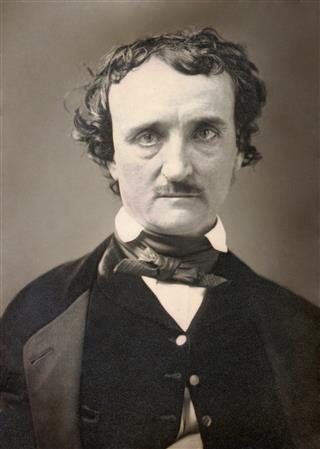Why is the Sky Dark at Night? You might think that the answer is simple and obvious. The sky appears dark because our side of Earth faces away from the Sun. But then, the universe is endless, it contains billion galaxies and innumerable luminous stars that we should be able to see their light from a particular distance away. Therefore, the night sky should be bright as noon!
The dark night sky paradox was a problem that dogged many astronomers since Kepler. But it was the physician and astronomer Wilhelm Olbers, a man of amazing intellect, the first who tried to address the problem. He theorized that interstellar space is not transparent, but contains dust which absorbs energy from the stars, preventing some of their light from reaching us on Earth. The dark night sky problem was named after him the Olbers’ Paradox.
 Edgar Alan Poe. Unknown author; Restored by Yann Forget and Adam Cuerden / Public domain: https://commons.wikimedia.org
Edgar Alan Poe. Unknown author; Restored by Yann Forget and Adam Cuerden / Public domain: https://commons.wikimedia.org
Curiously enough, it was the writer Edgar Allan Poe that first came up with at least part of the answer. Edgar Allan Poe, famous for his tales and poems of mystery, had a keen interest in science and in the field of cosmology in particular. Just one year before his premature death in 1849, Poe wrote Eureka: An essay on the material and spiritual universe, a strange, intensive, and metaphysical, yet quite scientific in content, prose poem, which he dedicated to the naturalist Alexander von Humboldt.
“I design to speak of the Physical, Metaphysical and Mathematical – of the Material and Spiritual Universe – of its Essence, its Origin, its Creation, its Present Condition and its Destiny.”
In Eureka, Poe claimed, among other things, that the universe is finite – in 1848 a finite-aged universe was mere speculation, and adopted a more philosophical phraseology of Newton’s Law of Gravitation, claiming that gravity is nothing but the attraction of every atom to the other atoms.
By Putnam – Reproduced in Joseph Wood Krutch’s Edgar Allan Poe: A Study in Genius (1926). Credited to the New York Public Library., Public Domain, https://commons.wikimedia.org/w/index.php?curid=3629139
“Every atom, of every body, attracts every other atom, both of its own and of every other body, with a force which varies inversely as the squares of the distances between the attracting and attracted atom.”
Poe also pondered the question of the Olders’ Paradox. He suggested that the universe is not old enough to fill the sky with light. Is also endless in size; we see only a tiny part of it, and that observable part contains too few stars to fill up the sky with light. Poe knew that light moves extremely quickly but he claimed that there hasn’t been enough time for the light to reach us from farthest reaches of the universe.
“No astronomical fallacy is more untenable, and none has been more pertinaciously adhered to, than that of the absolute illumination of the Universe of Stars. The reasons for limitation, as I have already assigned them, à priori, seem to me unanswerable; but, not to speak of these, observation assures us that there is, in numerous directions around us, certainly, if not in all, a positive limit—or, at the very least, affords us no basis whatever for thinking otherwise. Were the succession of stars endless, then the background of the sky would present us an uniform luminosity, like that displayed by the Galaxy—since there could be absolutely no point, in all that background, at which would not exist a star. The only mode, therefore, in which, under such a state of affairs, we could comprehend the voids which our telescopes find in innumerable directions, would be by supposing the distance of the invisible background so immense that no ray from it has yet been able to reach us at all. That this may be so, who shall venture to deny? I maintain, simply, that we have not even the shadow of a reason for believing that it is so.”
In the 1920s American astronomer Edwin Hubble demonstrated the existence of other galaxies besides the Milky Way and that these galaxies are moving away from ours. What Hubble observed when he looked at the distant galaxies, was that their light was redshifted (stretched out to longer wavelengths), an effect became known as the Hubble expansion, and thus the galaxy clusters were moving away from each other.
The universe is now believed to be approximately 13.8 billion years old and current observations show that the bulk of material in space is non-luminous dark matter. Poe was right. But there is also another, additional, reason of why the sky is black. Stars, like our Sun, shine for a few billion years, before they consume their supply of fuel and collapse into a white dwarf. The collapse of the old stars provides material that will give birth to a new generation of stars. But this material is not enough to provide fuel that would keep the stars shining forever and fill up all the space with light. And so the night sky is dark.
References and further reading
Edgar A. Poe, Eureka: An essay on the material and spiritual universe
Soter, Steven, and Neil deGrasse Tyson. 2001. Cosmic horizons: astronomy at the cutting edge. New York: New Press.
“Heinrich Olbers.” Astronomy & Space: From the Big Bang to the Big Crunch. Gale, 2008. Biography in Context. Web. 22 Apr. 2016, 2008. Biography in Context. Web. 22 Apr. 2016
